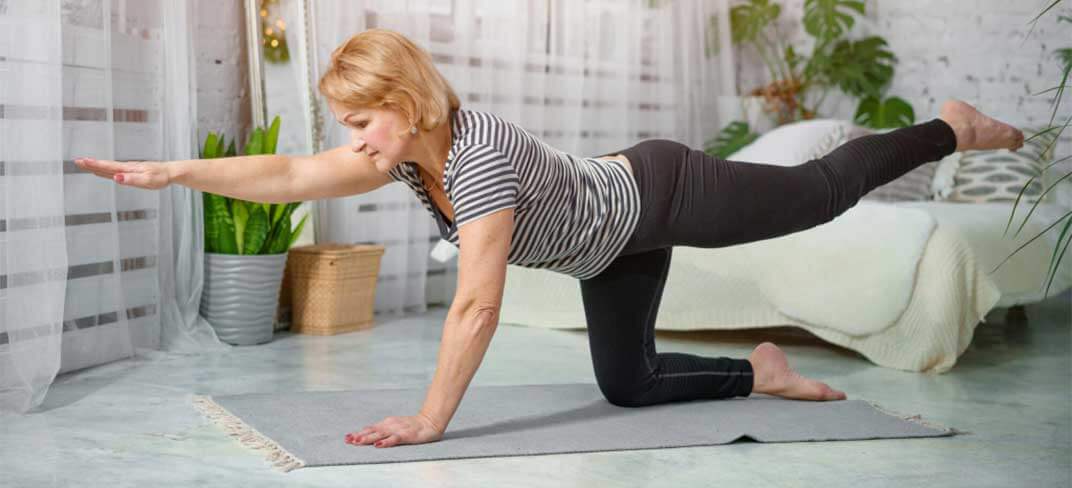Low Impact Cardio for Your Joints

You might have heard the term low-impact exercise. But what is it and how can it help you if you have joint pain?
Low-impact exercises are cardiovascular workouts that are either non-weight bearing (such as swimming), or that will always involve one foot being on the ground (such as walking). Elliptical or rowing machines and cycling are other great examples of low-impact workouts.
Low impact does not mean these exercises have a low impact on your health and fitness. “Impact” refers to the impact on your joints. Many low-impact exercises can be challenging and beneficial to your health, while also not putting too much stress on your joints.
The World Health Organisation recommends 150 to 300 minutes of moderate to vigorous aerobic activity each week and you can meet that recommendation through low-impact activities.
For people suffering from joint or knee pain exacerbated by running or plyometric (jumping) workouts, low-impact workouts can be an ideal way to exercise. Despite weighted exercises potentially being more effective in building bone or preventing bone loss, low-impact workouts are much less likely to cause a fracture or an overuse injury that can come about with the high-impact workouts.
The Benefits of Low-Impact Exercise
As mentioned, low impact does not mean lesser health benefits. According a study by the HSE, walking helped preserve bone health for women and prevent osteoporosis.
In other studies, researchers found that swimming helps people lose weight and improve cardiorespiratory fitness. Improving your body’s cardiorespiratory fitness improves your body’s ability to transport oxygen while exercising and contributes to better overall health.
Here are a few ways low-impact exercise can help you improve your health.
Types of Low-Impact Workouts:
Here are a few ways low-impact exercise can help you improve your health.
Walking Workout Options
Tempo walk: A “tempo” workout means setting a brisk pace and maintaining it for a long period of time. It’s not a sprint, but you need to put in the effort to keep the pace. It works well outdoors or on a treadmill. Always start with a 5 minute, moderately paced walk as a warm-up. Follow that with walking at an “uncomfortably” intense pace for 15 minutes. Finish the workout by meeting the same pace as your warmup, but now, to help your body cool back down to its normal state.
Ladder walk: The Ladder walk is a treadmill workout. Start with a warmup walk between 8-12 kmh for 5 minutes with a 1% incline. Steadily increase the incline by .5% every two minutes until hitting 4% and stay there for 15 minutes. 17 minutes after starting, begin “laddering” back down, decreasing the incline .5% every two minutes until returning to 1%.
Swimming Laps
If you have access to a pool but have never tried lap swimming, a few swimming lessons can be very helpful to get started. Learning the best ways to control your breathing and the best stroke and kicking techniques can make your workouts more effective.
One of the most important aspects of swimming is creating a rhythm with your breathing, such as deciding whether you are going to breathe with every second or third stroke. Start by setting a goal for how many laps you would like to be able to swim consecutively. Focusing on time is also a great way to set goals for yourself, such as working on being able to swim 30 minutes without stopping.
Cycling as a Low-Impact Workout
A great and fun way to do a low-impact workout is by taking an indoor cycling class. They teach you how to keep a rhythm on the bike and despite being low-impact, can still be high-intensity.
If you are looking to spend more time outside, a bicycle is another great option. Taking a long ride is a great low-impact workout that allows you to adjust the workout as you please, you’re in control of where you ride.
In order to increase the difficulty, find nearby hills and work on doing some climbs:
- A hill that takes around three minutes to climb is a great workout. Try to find a climb that is steep enough to be challenging, but still allows you to remain seated.
- It’s always best to start with a warmup. Start with five minutes of biking up the hill at the fastest pace you can and time yourself. Coast back down the hill and let your body recover.
For a great workout, climb the hill five to eight times and try not to let your time climbing the hill be slower than your previous attempt.
For more information on joint replacement options, make an appointment to see one of our consultant orthopaedic surgeons at UPMC Whitfield Hospital, UPMC Kildare Hospital, or UPMC Aut Even Hospital.